
What's New In Speak - April 2024
Interested in What's New In Speak February 2024? Check out this post for all the new updates available for you in Speak today!
We live in a world where Artificial Intelligence (AI) is taking over many aspects of our lives. From healthcare to retail, AI is being used to make decisions, automate processes, and drive efficiency. One of the core components of AI is the use of large language models, which allow machines to understand and process human language.
In this blog post, we’ll take a look at the current best, high-performance large language models, and how they can be used to improve your business. We’ll also explore how these models can help with market research, customer experience management, product research, SEO, business analysis, data science, and academic research.
A language model is a set of mathematical tools and algorithms used to analyze, process, and represent natural language (or human language). This includes English, Spanish, French, Chinese, and any other language spoken by humans. The goal of language models is to enable machines to understand, process, and generate texts in a human-like manner.
Language models can take various forms. Some models are shallow, meaning they are limited in their ability to understand and process language. Other models are deep, meaning they are able to understand and process complex language.
The most advanced language models are “large” language models. These models are “large” because they are trained on massive amounts of data (usually billions of words). They are also “high-performance” because they are able to accurately and quickly process and understand language.
There are several large language models currently being used in the world of AI. The most popular models are Google’s BERT, OpenAI’s GPT-3, and Microsoft’s Transformer.
Google's BERT is a deep learning algorithm that can be used to understand and process natural language. It was released in 2018, and it has become one of the most widely used language models in the world.
GPT-3 is a large-scale language model that was released in 2020. It is able to generate natural language from input data, and it is being used in many AI applications. There are continual advancements here with the recent OpenAI release of ChatGPT.
The landscape of artificial intelligence has witnessed a remarkable leap with the advent of Generative Pre-trained Transformer 4 (GPT-4), a cutting-edge language model developed by OpenAI. As the fourth iteration in the GPT series, GPT-4 was unveiled to the public on March 14, 2023, and has since garnered significant attention for its advanced capabilities. Access to GPT-4 is facilitated through ChatGPT Plus, a subscription-based service, while commercial users can join a waitlist to access the model's API.
GPT-4's architecture is based on the transformer model, and its training process involves two key stages: pre-training and fine-tuning. During pre-training, GPT-4 learns to predict subsequent tokens in a sequence using a diverse dataset that includes publicly available content as well as data sourced from third-party providers. The fine-tuning phase employs reinforcement learning, incorporating feedback from both humans and AI to optimize the model's alignment with human values and adherence to ethical guidelines.
GPT-4's introduction to the ChatGPT platform has been met with positive feedback, as users have noted its enhanced performance compared to the earlier GPT-3.5 version. Despite these advancements, GPT-4 is not without its limitations, and some challenges from previous versions persist. A notable distinction of GPT-4 is its multimodal nature, which allows the model to process both textual and visual inputs. This capability enables GPT-4 to interpret images, summarize text within screenshots, and respond to queries that include diagrams.
OpenAI has remained discreet about certain technical details of GPT-4, including the model's size. However, it is known that GPT-4 is available in two versions, each with different context window lengths: 8,192 and 32,768 tokens. This expansion in context window size represents a significant upgrade from GPT-3 and GPT-3.5, which were limited to 2,049 and 4,096 tokens, respectively.
GPT-4's ability to process both text and images sets it apart from its predecessors. This multimodal functionality allows GPT-4 to perform tasks such as identifying humor in unconventional images, summarizing text within visual content, and answering questions that incorporate diagrams.
OpenAI has introduced an innovative feature known as the "system message" to enhance user control over GPT-4's behavior. Through this feature, users can provide natural language directives to specify the model's tone and task. For instance, users can instruct GPT-4 to adopt the persona of a "Shakespearean pirate" or to format responses in JSON. GPT-4 is designed to adhere to the system message, even if subsequent user interactions request a deviation from the initial directive.
Microsft's Transformer is a deep neural network which is used to process natural language. It was released in 2017, and it is used in many of Microsoft’s products and services.
Cohere is building large language models that are showing promise. Like OpenAI, you can interact through APIs and a playground interface and select different models, sizes, and functions within those models.
Stability Ai has built a large language model that is being used primarily for text-to-image and has taken the world by storm. This model continues to improve with constant updates, releases, improvements and configurations by other developers who love their open-source capacities.
Large language models can help businesses in a variety of ways. Here are just a few examples:
Large language models can be used to quickly and accurately analyze large amounts of data. This can be used to generate insights into customer behaviour, preferences, and trends.
If you are interested in learning about how artificial intelligence is being used in market research, you can check out our guide to data transcription in market research.
Large language models can be used to process customer feedback and generate insights into customer satisfaction. This can help businesses identify areas where their customer experience can be improved.
Large language models can be used to generate insights into product performance and customer preferences. This can help businesses improve existing products and develop new products.
Large language models can be used to analyze website content and improve search engine rankings. We've seen this become a significant function of platforms like Jasper, Copy Ai and more. While there are some risks to using large language models for search engine optimization, it is undoubtedly being done and being used to drive traffic.
Large language models can be used to analyze large amounts of data and generate insights into performance. This can help businesses identify areas where they can improve their operations.
Large language models can be used to process large amounts of data and generate insights into customer behaviour, market trends, and more.
Large language models can be used to process and analyze large amounts of data for research purposes. We've seen adoption in analyzing large numbers of interviews, focus groups and more. If you are interested in the best academic research tools (some of which are using large language models) check out our guide!
Large language models are powerful tools that can help businesses in a variety of ways. From market research to customer experience management, large language models can help businesses generate insights and improve their operations. The most popular large language models currently being used are Google’s BERT, OpenAI’s GPT-3, and Microsoft’s Transformer. These models can help businesses gain a better understanding of their customers, markets, and operations.
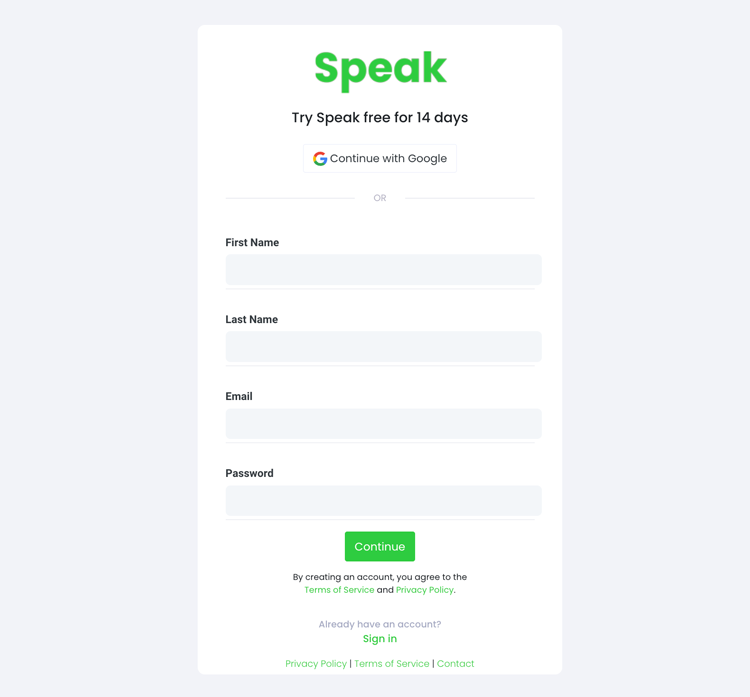
To start your transcription and analysis, you first need to create a Speak account. No worries, this is super easy to do!
Get a 7-day trial with 30 minutes of free English audio and video transcription included when you sign up for Speak.
To sign up for Speak and start using Speak Magic Prompts, visit the Speak app register page here.
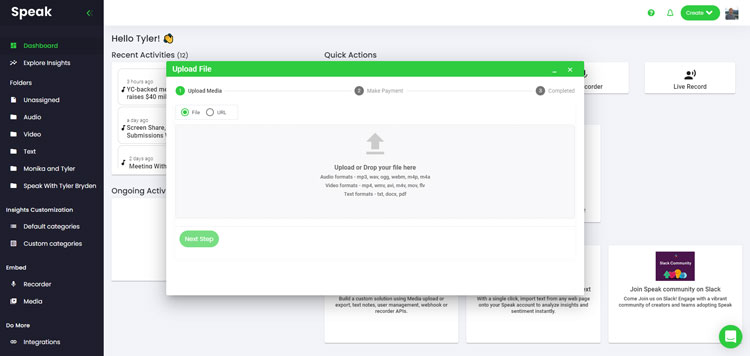
We typically recommend MP4s for video or MP3s for audio.
However, we accept a range of audio, video and text file types.
You can upload your file for transcription in several ways using Speak:
You can also upload CSVs of text files or audio and video files. You can learn more about CSV uploads and download Speak-compatible CSVs here.
With the CSVs, you can upload anything from dozens of YouTube videos to thousands of Interview Data.
You can also upload media to Speak through a publicly available URL.
As long as the file type extension is available at the end of the URL you will have no problem importing your recording for automatic transcription and analysis.
Speak is compatible with YouTube videos. All you have to do is copy the URL of the YouTube video (for example, https://www.youtube.com/watch?v=qKfcLcHeivc).
Speak will automatically find the file, calculate the length, and import the video.
If using YouTube videos, please make sure you use the full link and not the shortened YouTube snippet. Additionally, make sure you remove the channel name from the URL.
As mentioned, Speak also contains a range of integrations for Zoom, Zapier, Vimeo and more that will help you automatically transcribe your media.
This library of integrations continues to grow! Have a request? Feel encouraged to send us a message.
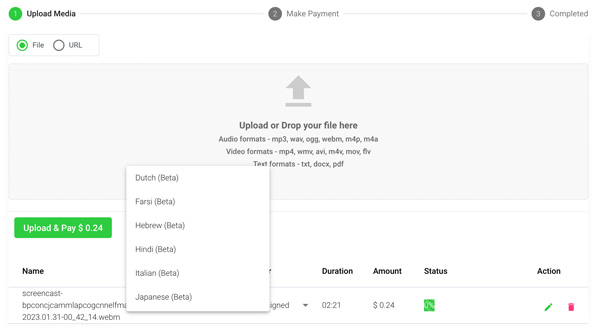
Once you have your file(s) ready and load it into Speak, it will automatically calculate the total cost (you get 30 minutes of audio and video free in the 7-day trial - take advantage of it!).
If you are uploading text data into Speak, you do not currently have to pay any cost. Only the Speak Magic Prompts analysis would create a fee which will be detailed below.
Once you go over your 30 minutes or need to use Speak Magic Prompts, you can pay by subscribing to a personalized plan using our real-time calculator.
You can also add a balance or pay for uploads and analysis without a plan using your credit card.
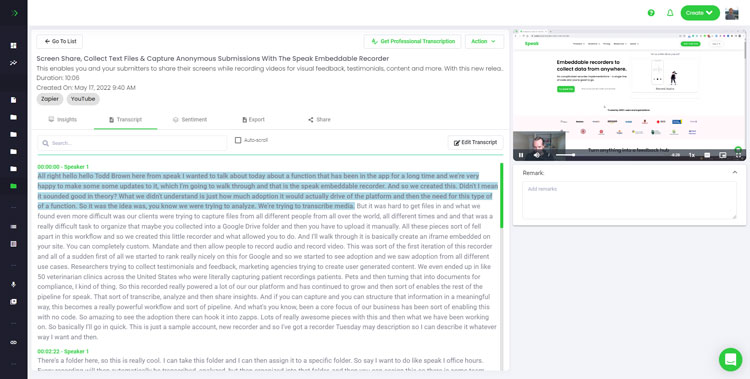
If you are uploading audio and video, our automated transcription software will prepare your transcript quickly. Once completed, you will get an email notification that your transcript is complete. That email will contain a link back to the file so you can access the interactive media player with the transcript, analysis, and export formats ready for you.
If you are importing CSVs or uploading text files Speak will generally analyze the information much more quickly.

Speak is capable of analyzing both individual files and entire folders of data.
When you are viewing any individual file in Speak, all you have to do is click on the "Prompts" button.
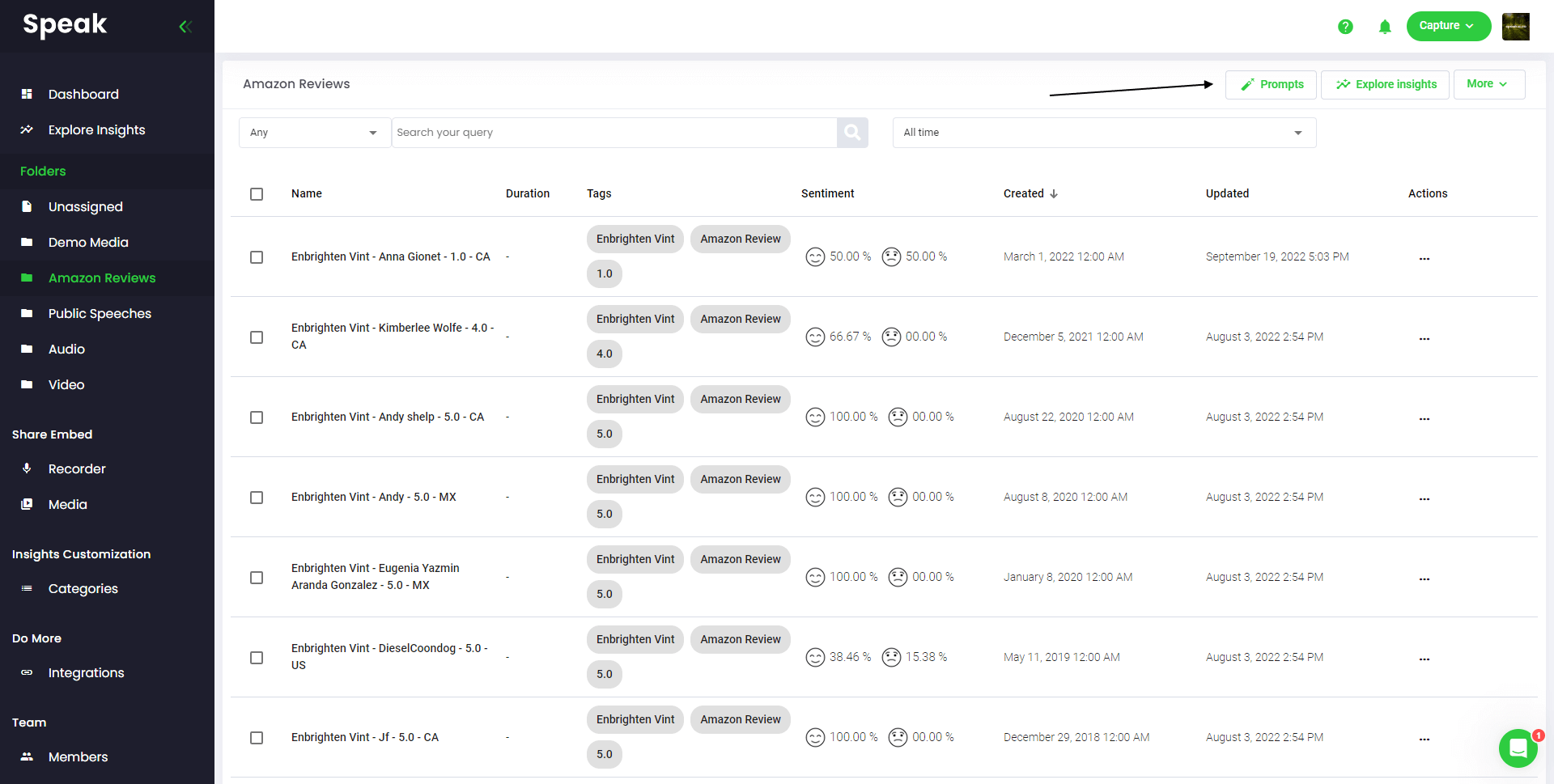
If you want to analyze many files, all you have to do is add the files you want to analyze into a folder within Speak.
You can do that by adding new files into Speak or you can organize your current files into your desired folder with the software's easy editing functionality.
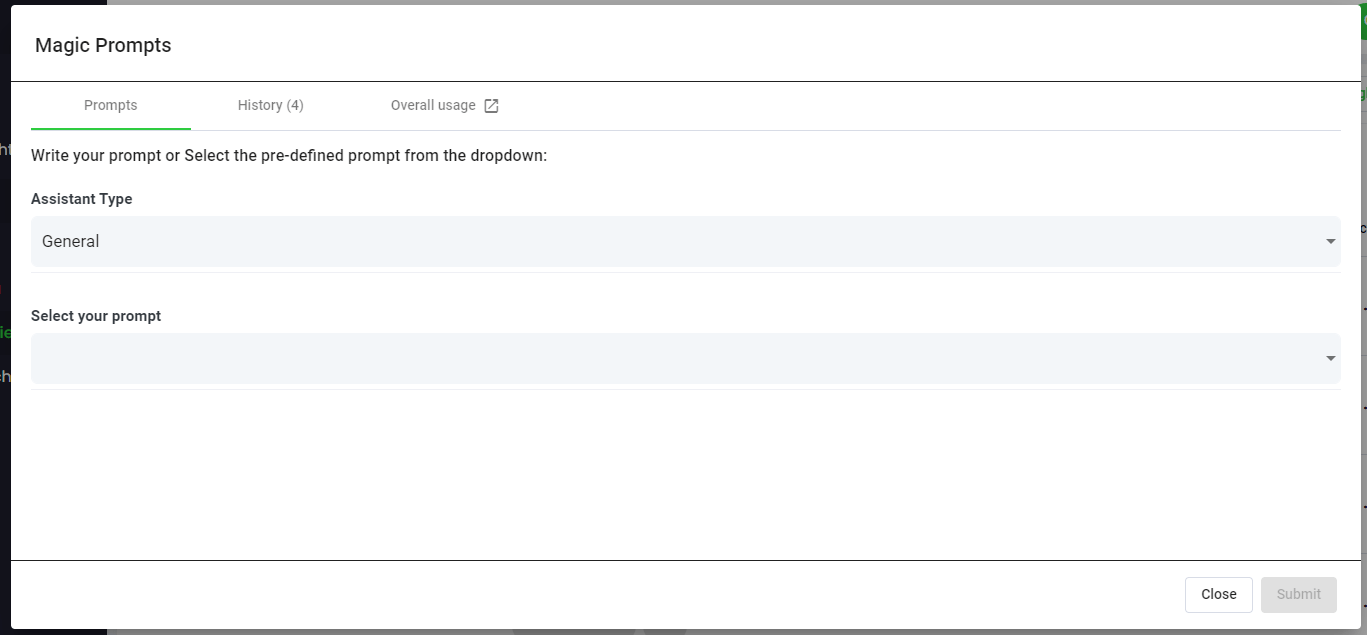
Speak Magic Prompts leverage innovation in artificial intelligence models often referred to as "generative AI".
These models have analyzed huge amounts of data from across the internet to gain an understanding of language.
With that understanding, these "large language models" are capable of performing mind-bending tasks!
With Speak Magic Prompts, you can now perform those tasks on the audio, video and text data in your Speak account.

To help you get better results from Speak Magic Prompts, Speak has introduced "Assistant Type".
These assistant types pre-set and provide context to the prompt engine for more concise, meaningful outputs based on your needs.
To begin, we have included:
Choose the most relevant assistant type from the dropdown.

Here are some examples prompts that you can apply to any file right now:
A modal will pop up so you can use the suggested prompts we shared above to instantly and magically get your answers.
If you have your own prompts you want to create, select "Custom Prompt" from the dropdown and another text box will open where you can ask anything you want of your data!
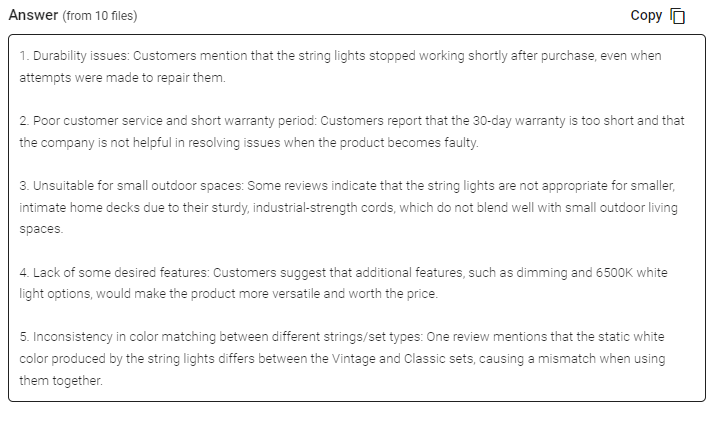
Speak will generate a concise response for you in a text box below the prompt selection dropdown.
In this example, we ask to analyze all the Interview Data in the folder at once for the top product dissatisfiers.
You can easily copy that response for your presentations, content, emails, team members and more!
Our team at Speak Ai continues to optimize the pricing for Magic Prompts and Speak as a whole.
Right now, anyone in the 7-day trial of Speak gets 100,000 characters included in their account.
If you need more characters, you can easily include Speak Magic Prompts in your plan when you create a subscription.
You can also upgrade the number of characters in your account if you already have a subscription.
Both options are available on the subscription page.
Alternatively, you can use Speak Magic Prompts by adding a balance to your account. The balance will be used as you analyze characters.
Here at Speak, we've made it incredibly easy to personalize your subscription.
Once you sign-up, just visit our custom plan builder and select the media volume, team size, and features you want to get a plan that fits your needs.
No more rigid plans. Upgrade, downgrade or cancel at any time.
When you subscribe, you will also get a free premium add-on for three months!
That means you save up to $50 USD per month and $150 USD in total.
Once you subscribe to a plan, all you have to do is send us a live chat with your selected premium add-on from the list below:
We will put the add-on live in your account free of charge!
What are you waiting for?
If you have friends, peers and followers interested in using our platform, you can earn real monthly money.
You will get paid a percentage of all sales whether the customers you refer to pay for a plan, automatically transcribe media or leverage professional transcription services.
Use this link to become an official Speak affiliate.
It would be an honour to personally jump on an introductory call with you to make sure you are set up for success.
Just use our Calendly link to find a time that works well for you. We look forward to meeting you!
Get a 7-day fully-featured trial.


Interested in What's New In Speak February 2024? Check out this post for all the new updates available for you in Speak today!

Interested in What's New In Speak February 2024? Check out this post for all the new updates available for you in Speak today!
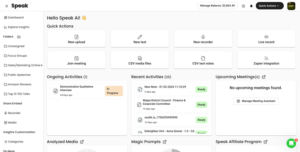
Interested in What's New In Speak February 2024? Check out this post for all the new updates available for you in Speak today!
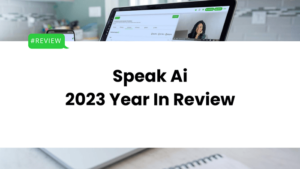
Thank you for continuing to be part of this journey - it means the world to us. Below is a summary of our 2023 at
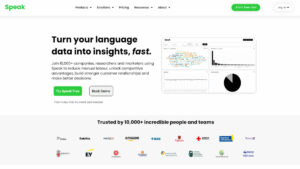
Interested in The Best Executive Research Firms? Check out the dedicated article the Speak Ai team put together on The Best Executive Research Firms to learn more.

Interested in The Best Consumer Research Firms? Check out the dedicated article the Speak Ai team put together on The Best Consumer Research Firms to learn more.

Powered by Speak Ai Inc. Made in Canada with
Use Speak's powerful AI to transcribe, analyze, automate and produce incredible insights for you and your team.